|
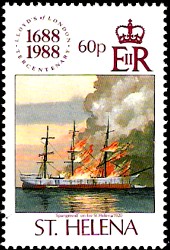
|
Maritime Topics On Stamps :
Fire aboard!
| |
The burning 'Spangereid'
|
|
On many a ship a raging fire caused the loss of human lives and even
the total ship. This was hardly surprising during the age of wooden
ships and abundant sail cloth. Nevertheless even modern ships built of
steel have enough combustible stuff aboard to set the ship afire.
Freighters transport dangerous cargoes which may ignite by spontaneous
combustion. For example high explosive chemicals can start a disaster.
For example dangerous explosive gas mixtures may build in empty tanks
of tank ships. An electric short circuit can start a cable fire. Last
but not least we have smoking the occasional cigarette in places,
where it is strictly forbidden ...
| |
Often the condition of the ships played a major role in ship fires.
Especially on older ships alarm systems and/or fire extinguishers were
in bad shape or didn't work at all. Sometime the crew was not properly
trained to handle the fire equipment and did not know what to do. Even
the ship's captain and officers failed in critical moments.
| >
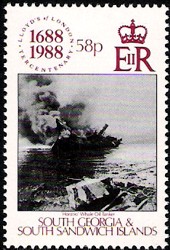
| |
On the first stamp we can see the full rigger 'Spangereid', built in
1896 as 'Fairport' at Glasgow. In October 1920 she was bound for
Sweden, loaded with african coal. The cargo caught fire near the
island of St. Helena and the ship sank.
To the right stamp we can see the tankship 'Horatio', built in 1892 at
Newcastle. In 1916 the ship stayed at the port of Leith/South Georgia.
The whole cargo consisting of 2,000 tons of whale oil ignited causing
the ship sink.
|
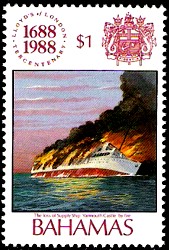
|
On the left stamp we can see the 'Yarmouth Castle', built in 1927 as
'Evangeline'. In November of 1965 she was on a cruising trip carrying
372 passengers and 174 crew members into the Caribean Sea. After
midnight a fire started in one cabin, which spread out stunningly fast
through the long corridors. The master inspected the fire but did not
send an emergency signal. Twenty minutes later he had to issue the
command to leave the ship. The bridge, the wireless room and some of
the lifeboats were already burning. Sending an SOS signal was
impossible by now. Fortunately the ship was sighted in time by the
'Bahama Star' and the 'Finnpulp'. Both ships saved 450 people. In one
of the last lifeboats which cleared the ship were the captain and his
officers. The 'Yarmouth Castle' sank shortly thereafter.
|
|
On the 22nd of December, 1963 the 'Lakonia' passed the island of
Madeira 180 nautical miles to the north. The ship was built in 1931.
Now 651 passengers and 385 crew members enjoyed a pleasant christmas
cruising voyage. Suddenly a fire started in a barbershop. A pressure
boiler exploded and almost immediately the ship was filled with thick
smoke. Panic spread, the captain ordered to put on the life jackets,
but the loudspeakers were not working any more. Some passengers got
the order to assemble in the dining hall, others flooded the boat
deck. Chaos ruled. The wireless operator was able to send an SOS
signal and only a short time later six ships arrived on the scene.
They cooperated perfectly and were able to save 908 people. 128 people
died in the fire or were missing. Tugs tried to tow the 'Lakonia', but
the ship listed more and more and on the seventh day she sank in the
Atlantic Ocean.
|
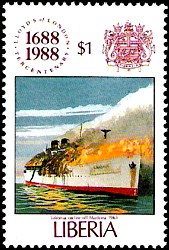
|
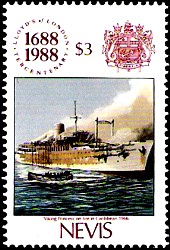
|
The 'Viking Princess', a Norwegian passenger ship, was built in 1950
at St. Nazaire. On the 8th of April, during a cruising trip through
the Caribean Sea, fire broke out in the engine room. The fire spread
very fast and the captain immediately ordered to leave the ship.
Emergency signals were sent. Several ships reached the 'Viking
Princess' and saw the vessel engulfed in flames. Lifeboats under motor
were towing other lifeboats clear from the burning ship. The rescuers
succeeded to save 492 person of 494. Only two people did not survive
the flames. Four days later the US Navy and the Coast Guard towed the
charred wreck to Kingston, where it was sold for dismantling.
|
|
The 'Atlantic Empress' was a so-called 'supertanker' built in 1974 at
Odense with the following measures: length 347 meters, beam 51 meters,
draft 28m, tons deadweight 292,666. In July of 1979, she was
travelling in the Caribean Sea, carrying 270,000 tons of crude oil.
There she collided with another supertanker, the 'Aegean Captain'.
Visibility was low, but both ships were equipped with RADAR systems.
The bow of the 'Aegean Captain' crashed into the port side of the
'Atlantic Empress', which had right of way. Immediately both ships
were engulfed by flames. 29 of 34 crew members aboard the 'Atlantic
Empress' lost their lives, because they fumbled with the lifeboats.
280,000 tons oil spilled into the sea and the thick oil carpet quickly
reached the coast of Tobago. The Atlantic Empress' burned for 13 days.
Again and again some tanks exploded until the wreck finally sank.
|
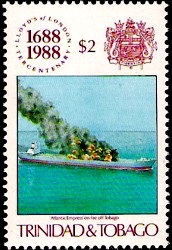
| |
The
fire aboard the 'Aegean Captain' was extinguished and she was towed to
Curacao. After unloading the remaining oil she was declared
unrecoverable and was wrecked.
|
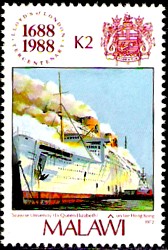
|
In her times the 'Queen Elizabeth' was the greatest passenger ship of
the world and the pride of all of the British merchant navy. She was
built in 1940 with a length of 1031 ft, a gross tonnage of 83,673 and
a speed of 32 knots. During World War II she was used as a large troop
transport and afterwards she ran between Southampton and New York. In
1968 the owning Cunard Line sold her to Americans as she generated not
enough revenue any longer. Two years later she was towed to Hongkong
and renamed to 'Seawise University'. Her new owner C.Y.Tung wanted to
rebuild the ship into a swimming university. But the renovation
process was sabotaged as multiple fires broke out at different places
all over the ship at the same time. An oil kettle exploded and the
fire spread over five decks.
| |
The local fire brigade pumped immense
quantities of water into the 'Queen Elizabeth' which finally
exstinguished the fires but caused the ship to list and capsize. She
sank on the 9th of January, 1972. Two months of investigation only
revealed 'one or two unknown persons who lighted the fire'.
|
|
The 'General Slocum', built in 1891 with a wooden hull, was a paddle
steamer working as a ferry on the Hudson River, New York. On the 15th
of June, 1904, she started her regular sunday cruise with 1388 people
aboard, among them many children of a sunday school. After one hour a
fire started in a drug store containing many colours and inflammable
goods. A strong wind supported the quick spreading of the fire. In
less than minutes the wooden superstructure was burning. The captain
wanted to run the ship aground but they were just passing great oil
tanks along the shores. Many passengers jumped into the water, a lot
of them drowned. Others burned to death aboard. A tug, which tried to
help, caught fire by itself and had to pull out. Only 30 minutes after
the fire started the burning ship began to sink. 1021 people died.
|
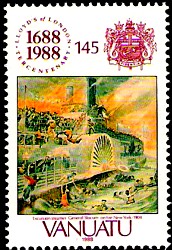
| |
Afterwards the investigation revealed, that all fire pipes were rot
and life belts were placed too high, so women and children could not
reach them. The crew was not able to lower a life boat to the sea. The
captain was arraigned and condemned to imprisonment for homicide.
|
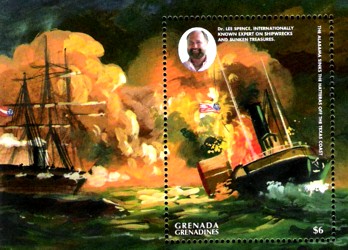 |
Now on to some stamps depicting our theme 'fire aboard' caused by
effects of war. Here we can see the gunboat 'Hatteras' of the United
States. Built in 1850, she was a paddle steamer with auxiliary sails.
During the American Civil War, in January of 1863, the 'Hatteras'
cruised off the coast of Galveston. The crew sighted a British ship
and thougt it a simple blockade runner. Closing in, it turned out to
be the brand new 'Alabama', which immediately started firing with her
superior batteries. The 'Hatteras' was heavily damaged, she started
burning and finally sank. Only two persons died, the others were
picked up by the 'Alabama' and taken prisoners.
|
|
This is a stamp of the burning 'Alarm'. Built in 1777 at New York she
was employed in the American Independence War. She belonged to the
British fleet and was commanded by Philippe d'Auvergne. When she
patrolled along the coast of Long Island she was cut off by the
arrival of the French fleet. To save the crew and the arms the ship
was beached and afterwards set on fire.
|
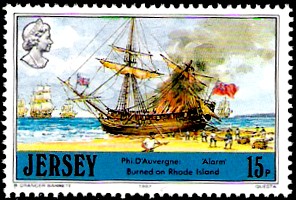
|
|
The next stamps depict two war sceneries. Both pictures show attacks
using fire ships. This included lightening (i.e. sacrificing) the own
ships and steer them directly into the fleet of the enemy to cause as
much damage as possible!
|
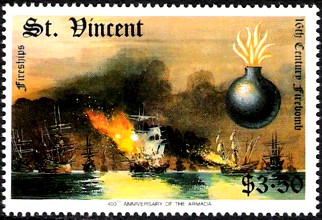
|
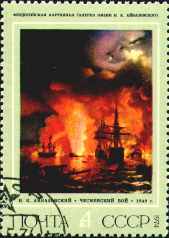
| |
In 1588 the fabled Spanish Armada and the English fleet clashed in
several naval engagements in the British Channel. When the Spanish
were at anchor off the coast of Calais the Englishmen employed the
so-called fire ships. The wind and the tide drove eight burning ships
into the Armada. Total chaos arose. The Spanish ships had to slip
their anchors to avoid catching fire and reach the free sea. And this
was the beginning of the end.
|
In 1770 the Russian fleet attacked the Turkish fleet at anchor off the
island Chios in the Aegean Sea. The Russians used four torch ships to
weaken the enemy. The fires spread quickly from ship to ship. Within
short time the whole Turkish fleet except one ship was ablaze. This
battle was painted by the Russian sea painter Aiwassowski. We can see
his picture on the stamp above.
|
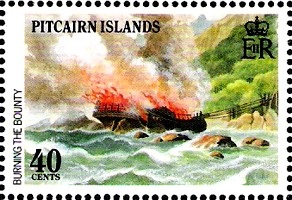
|
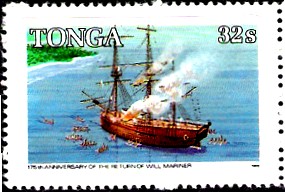
| |
In 1789 most of the crew aboard the English sailing ship 'Bounty'
mutinied. Their captain Bligh was disembarked into a small boat and the remaining crew
sailed to Tahiti, later on to Pitcairn. There they burned the 'Bounty' to assure never
to return to England. This is depicted on the stamp.
|
This stamp depicts the burning 'Port Au Prince'. It carried the
Englishman Will Mariner to Tonga in 1805. The ship was captured by
natives and set on fire. The whole crew was taken as prisoners and
probably doomed, but Mariner was able to befriend the chief. After
several other stations he finally managed to return to England in
1811.
|
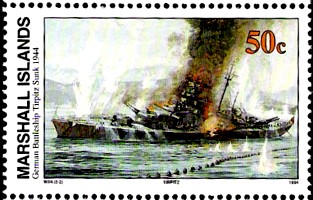 |
Here we can see see the burning German battleship 'Tirpitz' in a
Norwegian fjord. Built in 1940 the 'Tirpitz' was used against Allied
convoys in the North Atlantic. For four years Britain and Russia tried
to sink the ship and at least they had success. In November 1944 the
British Air Forces used a newly developed 5.4 tons bomb, called 'Tall
Boy'. One of those bombs was able to penetrate the thick armour
plating of the ship and detonated inside the hull. The 'Tirpitz'
listed and sank, 1204 crew members died.
|
|
Once upon a time .... in the 4th century on the island of Korsika a
bad governor tortured the christs. Among them was a young believing
girl named Devote, who died in prison. Other christs put her on a
small boat to ship her to Africa to get her a proper christian burial.
During the voyage a heavy storm was setting and the ship seemed lost.
But suddenly a dove came out of the mouth of Devote, the storm
weakened and the boat reached the shores of Monaco. There she was
buried in a chapel and since that days this chapel is a place for
pilgrimage.
|
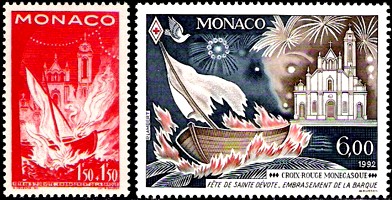
| |
One day her relics were stolen, but fishermen caught the
thief in his boat and brought the relics back. The boat was burned,
and even today there is a procession every year in honour of the holy
Devote. After the procession a boat is ritually set on fire and the
evening ended with fireworks.
|
This chapter 'fire aboard' could be a section in every collection
about distress at sea, sea rescue, ship catastrophes, collisions,
shipwrecking or stranding.
|